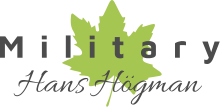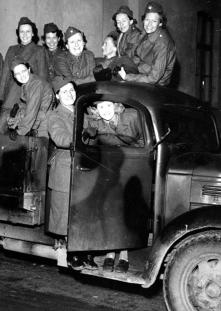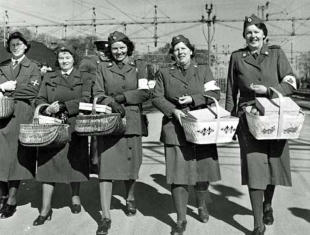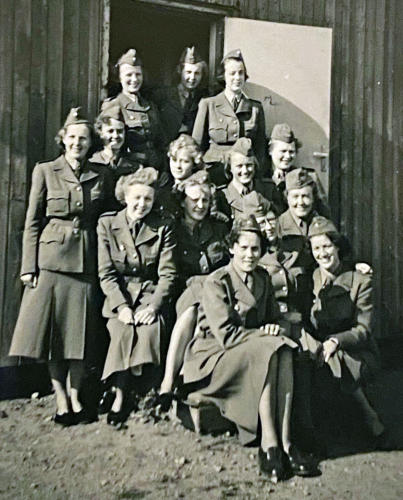

Copyright © Hans Högman 2020-12-15


Swedish Voluntary
Defense Services
Introduction
18 Voluntary Defense Services are today part of the
Swedish Total Defense (Swe: Totalförsvaret). These
voluntary services are auxiliary defense services. Its
members are voluntarily recruited and are being
trained for service with the Total Defense and civil
service in the case of a piece-time crisis in the
civilian society.
During WWI, the interest in participating in voluntary
defense services increased significantly. Women
supported the armed forces through fund-raising
but wanted also more specifically contribute with
sturdy work of some kind. That is the background of
the Women’s Voluntary Defense Services.
Many of the voluntary defense services were
established during WWI and in the 1920s.
Swedish Voluntary Defense
Services
Swedish: Frivilliga Försvarsorganisationer
Voluntary Motorcycle Corps - Frivilliga
motorcykelkårernas riksförbund (FMCK)
The Swedish Voluntary Motorcycle Corps (FMCK) is
training motorcycle orderlies for both the civilian
and the military part (Home Guards) of the Total
Defense. The Corps was established in 1929.
Voluntary Automobile Corps - Frivilliga
automobilkårernas riksförbund (FAK)
The Swedish Voluntary Automobile Corps (FAK) is
training drivers of heavy trucks and buses for the
transport sector of the Civil Defense. The Corps was
established in 1914 and has local corps units in all
Swedish Regions. Its members are foremost
professional truck drivers.
Voluntary Radio Service - Frivilliga
radioorganisationen (FRO)
The Swedish Voluntary Radio Service (FRO) is a
Swedish volunteer auxiliary defense service.
Experiences drawn from WWII led to the need for
improved communications skills of signal personnel.
Further training was made available, voluntarily, for
those who already were skilled radio operators.
Today FRO is open to all Swedish citizens.
FRO trains radio operators, technicians, squad
leaders, and communications staff for the Swedish
Home Guards and civilian operators for the Swedish
Civil Contingencies Agency, etc. FRO was established
in 1946.
Voluntary Flying Corps - Frivilliga flygkåren
(FFK)
The Swedish Voluntary Flying Corps (FFK) s a
Swedish volunteer auxiliary defense service. Its
main mission is to assist the Swedish Civil Defense
and the Rescue Services with flying capacities (pilots
and planes). The FKK is part of the Total Defense,
and as such an auxiliary service to both civilian and
military authorities. The Corps was established in
1961.
The pilots are trained through privately funded pilot
licenses or the Armed Forces. The corps carry out
voluntarily, assignments for the Swedish authorities
(for example, the Swedish Civil Contingencies
Agency) and the Armed Forces.
Federation for Voluntary Defense Education
- Försvarsutbildningsförbundet
(Försvarsutbildarna)
The Swedish Federation for Voluntary Defense
Education (Försvarsutbildarna) was earlier known as
Centralförbundet för befälsutbildning (CFB). This
organization was established 1942–1943 after a
reorganization of the former Sveriges
landstormsföreningars centralförbund, established in
1912. Voluntary training and education of officers
and NCOs is training performed by voluntary
defense services attached to the Federation for
Voluntary Defense Education. This education
foremost concerns conscript officers and NCOs with
all branches of the armed forces but also officers of
the reserve and Home Guards.
Voluntary Engineers - Insatsingenjörernas
riksförbund (IIR)
The Swedish Voluntary Engineers (IIR) is a volunteer
auxiliary defense service. The name of the service
was before 2007/2008 The Airfield Engineers
(Flygfältsingenjörsföreningen (FIFF)). IIR organizes
engineers, architects, contractors, specialists, and
entrepreneurs within building and infrastructure.
They recruit and educate personnel for military and
civil positions with the Total Defense.
They are a resource of competence to which military
and civilian organizations and agencies can turn to
obtain qualified personnel for the Total Defense.
Air Force Volunteers - Flygvapenfrivilligas
riksförbund (FVRF)
The Swedish Air Force Volunteers (FVRF) arrange
military further education of conscripts and
volunteers for specialist positions with the Air Force
Airbase Battalions. The Air Force Volunteers carry
out surveillance of airbases and restricted areas.
They give capability development courses for service
abroad and intelligence units with the Home
Guards. The FVRF personnel serve also as
instructors at Air Force Wings.
Voluntary Shooting Association - Frivilliga
skytterörelsen (FSR)
The Swedish Voluntary Shooting Association (FSR)
was a voluntary defense service and a large sports
association conducting shooting as a sport. It was
established in 1860 in the then fast-growing
sharpshooting association (Rifle Club -
Skarpskytterörelsen). On 30 May 2009, the
Voluntary Shooting Association was
disestablished.
Association for Defense Staff Development -
Försvarets personaltjänstförbund (FPF)
The FPF was established in 1955, but then by the
name “Förbundet för personalvårdsutbildning inom
det militära försvaret”. Its mission was initially to
support and educate staff within Care of Personnel
and regimental chaplains who received further
educations. In 1964, the service changed the name
to its present one. The FPFs mission today is
recruiting and educating staff within Care of
Personnel and Pastoral Care for the Swedish
Defense.
Swedish Blue Star - Svenska Blå Stjärnan
(SBS)
The Swedish Blue Star (SBS) was established in 1917
to care for the Army horses in the field. The service’s
first name was the Swedish Red Star “Svenska Röda
stjärnan” (compared to the Red Cross). The mission
for the Red Star was to be the animals’ counterpart
to the Red Cross. Injured Army horses suffered
badly during WWI and an international federation
was established for the care of horses in battle
conditions.
The Swedish Red Star educated and trained so-
called “Red Star nurses” for the care of horses, i.e.
medical orderlies for the Army horses. The Red Star
established also hospital stables, manufactured
horse bandages, and acquired medical instruments
and other equipment.
In 1940, during the Finnish Winter War with the
Soviets, the Swedish Red Star contributed with an
ambulance for horses. In Finland, the name of the
service, Red Star, wasn’t suitable since this was the
symbol used by the Soviet Army.
On 1 July 1941, the service, therefore, changed its
name to the Swedish Blue Star (Svenska Blå
Stjärnan).
The image to the left shows the badge
m/1941 of the Swedish Blue Star (the
Blue Star on white background). Image:
Armémuseum, ID: AM.091307.
The image to
the right
shows a female member
of the Swedish Blue Star
wearing uniform. Photo:
Stig Herbst (1916 -
1991). Image: Karlsborgs
fästningsmuseum, ID:
KBGF.010607. PDM.
In 1975, the last horses
in the Swedish Army were retired and thereby the
Swedish Blue Star’s attachment to the Army was
discontinued. The Blue Star’s mission was thereafter
to ensure and support the access of food and
provisions in states of crisis’ for the Total Defense.
Swedish Red Cross - Svenska röda korset
(SRK)
The Swedish Red Cross (SRK) is a Swedish
humanitarian organization and a member of the
International Red Cross and Red Crescent Movement.
The International Red Cross was founded in 1863, its
purpose is to protect life and health and to ensure
respect for the human being. It promotes mutual
understanding, friendship, cooperation, and lasting
peace amongst all peoples. The initial mission was
nursing and caring for injured and sick soldiers in
field conditions on the battlefield.
Today, the International Red Cross and Red Crescent
Movement, endeavors, in its international and
national capacity, to prevent and alleviate human
suffering wherever it may be found. It is a voluntary
relief movement not prompted in any manner by
desire for gain.
The original emblem of the Red Cross was officially
approved in Geneva in 1863. The Red Cross emblem
is the color-switched version of the Flag of
Switzerland, the Red Cross on white background,
in honor of the founder, Swiss businessman Jean-
Henri Dunant.
Under the Geneva Convention, The Red Cross
emblem is used in the protection of medical
orderlies in armed forces.
The image to the left is a badge (brooch)
for relief nurses with the Swedish Red
Cross. Image: Armémuseum, ID:
AM.087582.
The Swedish Red Cross (SRK) was established in
1865. Its purpose is to prevent and alleviate human
suffering wherever and whenever it occurs,
voluntarily and without discrimination. Within
Sweden, it operates
more than 1,000 local
branches, which are
run by local
committees.
The image to the right
shows members of
the Swedish Red
Cross wearing
uniform during WWII. They are wearing the Red
Cross armlet on their left sleeves (a white armlet
bearing a red cross). Image: Krigsarkivet.
Women’s Voluntary Defense Service, Lotta
Corps - Riksförbundet Sveriges lottakårer
(SLK)
The Lotta Corps (SLK), generally known as “Lottorna”
or “Lottakåren” is a Swedish Women’s Voluntary
Defense Service, established in 1924. The Lotta
Corps is an independent auxiliary defense service.
On 10 September 1924 Swedish Tyra Wadner
initiated the establishment of a women’s voluntary
defense service called the Landstorm Women of
Stockholm (Stockholms Landstormskvinnor). The
Landstorm was the Swedish army’s older ages
classes of draftees. The movement grew and spread
to other parts of the country and in 1930 the name
was changed to the Landstorm Women of Sweden
(Sveriges Landstormskvinnor (SLK)).
From 1936, all women’s voluntary auxiliary defense
services were allowed to serve in the field also in
times of war. The Landstorm Women was initially
only attached to the Army. However, in 1939 the
organization’s service was attached also to the Navy
and Air Force for non-combat duties.
Since the organization now was attached to all
armed services they changed their name to the
Swedish Lotta Corps (Svenska Lottakåren (SLK)).
The members of the corps are called lotta in singular
and lottor in the plural.
The image to the right shows the badge
of the Lotta Corps, a yellow cross on a
blue background, and the text SLK.
Image: Marinmuseum, ID: MM 25599.E.
The name “Lotta” comes from a heroic
poem called Fänrik Ståls Sägner (The Tales
of Second Lieutenant Stål), by Johan Ludvig
Runeberg, about a fictional woman named Lotta
Svärd who took care of wounded soldiers during
the Russo-Swedish War 1808-1809 in Finland.
Finland was until 1809 a part of Sweden. The epic
emphasizes the common humanity of all sides in
the conflict. The name of the Lotta Corps comes
from the fictional woman Lotta Svärd who took care
of wounded soldiers during this war.
In 1942, the Lotta Corps became an independent
organization.
The Lotta Corps has two types of attires; a civilian
dress (garb) used for their internal work and military
uniforms for field service.
The organization consists of women of all ages
throughout Sweden. The SLK’s purpose is to recruit
and educate women for tasks in the Swedish Total
Defense and to carry out comprehensive defense
training. The Lotta Corps works together with both
the Armed Forces and the Civilian Emergency
Preparedness.
The Lotta Corps is represented nationwide via local
Lotta Corps.
There are two different types of major missions for
the Lotta Corps, one with the Military Defense and
one with the Civil Defense.
One mission is the military commissions; these
members of the Lotta Corps sign a contract with the
Military and are appointed to posts within the
Armed Forces, for which duties they are trained.
Refresher training is compulsory.
The other type of mission is about supporting the
civil agencies in cases of a crisis. These Lotta
members sign a contract with civil agencies, and
their work will be carried out temporarily.
To fund the training and to support the
administration on all levels, the Swedish
Government subsidies the Lotta Corps with an
annual contribution to the organization.
The image to the right shows
members of the Lotta Corps
during a military exercise at
the end of the 1940s cooking
food at a field kitchen with
the Södermanland Regiment.
The officer is wearing
uniform m/1939. Photo:
Arsenalen, Bildarkivet,
Strängnäs, 2017.
The Lotta Corps arranges training and courses in
both Civil Defense and Military Defense for its
members. The Corps has its own Course Center,
Älvkarleö Estate.
In 1926, the Lotta Corps adopted their first dress, a
light gray-brown dress m/1926. The dress was
equipped with a white collar and white cuffs.
Headgear was a kerchief. A trench coat styled coat
was used as an outdoor garment. The Lotta dress is
a civilian dress used by all members of the Lotta
Corps. In 1931, the Lotta Corps adopted a new
dress, dress m/1931. The color of the dress was gray
with a white collar and white cuffs. The dress was
long-sleeved and single-breasted.
A corps badge was established for the Lotta Corps in
1925, the Lotta Badge (see above).
The image to the left
shows members of
the Lotta Corps (SLK)
lined up sometime
during WWII. They
are wearing the
m/1931 Lotta dress.
Image: Krigsarkivet.
In 1963, a new dress
for the Lotta Corps was designed and accepted as
its new dress.
For more information, see Service Uniforms of the
Swedish Lotta Corps (Lottakåren).
The above mentioned Lotta dresses were used for
their internal work. For field service the Lotta Corps
used military uniforms, from 1942; uniform m/1942
kv, (see below).








Swedish Auxiliary Naval Corps -
Sjövärnskårernas riksförbund (SVK RF)
The Swedish Auxiliary Naval Corps (“Sjövärnskåren”,
SVK) is a Swedish voluntary auxiliary naval defense
service. The service of the voluntary Naval Corps
comprises further education of seamen and officers
of the Swedish Navy; providing personnel to the
marine sector of the Swedish Home Guards;
encouraging young people to work in the Navy and
other maritime professions through its youth
organization “the Swedish Sea Cadet Corps (SSCC)”.
The Naval Corps is also a part of the International
Sea Cadet Association through the SSCC. The Naval
Corps was established in 1913 by the name Sveriges
Frivilliga Motorbåtskår (SFMK) (Swedish Powerboat
Corps). In 1941, it was reorganized into a military
voluntary auxiliary naval organization, attached to
the Navy, by the name “Sjövärnskåren” with its own
fleet of vessels. The Corps is wearing Navy uniforms.
Swedish Working Dog Association - Svenska
brukshundklubben (SBK)
The Swedish Working Dog Association (SBK) was
established in 1940 through a consolidation of
several small K9 clubs. SBK promotes the breeding of
working dogs and arranges dog shows and tests of
K9 orderlies and tracker dogs.
The organization train also dogs for the Swedish
Army and the Swedish Civil Contingencies Agency
(MSB).
The SBK is a voluntary defense service meeting the
Total Defense’s demand for trained K9 handlers and
working dogs with special skills, for example, rescue
dogs, guard-dogs, etc.
Swedish Parachute Association - Svenska
fallskärmsförbundet (SFF)
The Swedish Parachute Association (SFF) is a
voluntary defense service established in 1955. Its
mission is to organize, promote, and develop
Swedish parachuting.
Swedish Pistol Shooting Association -
Svenska pistolskytteförbundet (SPSF)
The Swedish Pistol Shooting Associating (SPSF) is a
voluntary defense service established in 1936. It is a
shooting sports organization promoting pistol and
revolver shooting, increased shooting skills, and
responsible handling of these weapons.
The leading discipline is in the field shooting,
followed by target-shooting.
Swedish Shooting Sports Federation -
Svenska Skyttesportförbundet (SvSF)
The Swedish Shooting Sports Federation (SvSF) is a
voluntary defense service. It is a Swedish shooting
sports association founded in 2009 through the
merger of the three organizations: Swedish Shooting
Sports Association (Svenska Sportskytteförbundet,
SSF); Frivilliga Skytterörelsen (FSR) and
Skytterörelsens Ungdomsorganisation (Skytte UO).
The former Frivilliga Skytterörelsen (FSR) (Voluntary
Shooting Movement) initially pursued its service with
target shooting using army rifles. When the Mauser
m/1896 rifle was adopted by the Swedish Army in
1896, it resulted in a great upturn for the shooting
movement.
Today, the SvSF pursue also shooting sports with
automatic weapons such as submachine-guns and
assault rifles.
Swedish Civil Defense League - Sveriges
civilförsvarsförbund (SCF)
The Swedish Civil Defense League (SCF) is a voluntary
defense service within the Civil Defense. Its mission is
to pursue an education of the public about how to
protect themselves in cases of natural disasters;
other outdoor emergencies; longer periods of power
shortage; situations with contaminated drinking
water; longer periods of isolation, etc.
The organization was established in 1937 by the
name “Riksluftskyddsförbundet (RLSF)”. Its present
name was adopted in 1951.
Swedish Transportation Service - Sveriges
bilkårers riksförbund (SBR)
The Swedish Women’s Transportation Service (SBR) is
a voluntary auxiliary defense service established in
1939. The organization educates and train female
drivers for the armed forces. The Federation of the
Women’s Transport Service, an umbrella organization
for all the local women’s Transportation Services, was
established in 1942 by the name “Sveriges kvinnliga
bilkårers riksförbund, SKBR”. In 2009, men also were
allowed to join the organization.
The image to the left shows the
emblem of the Swedish Transportation
Service (Svenska Bilkåren). Image:
Hemvärnsmuseet, ID: HVM.000436.
During WWII, with a shortage of fuel,
the cars and trucks were powered with producer gas
(gengas). The producer gas units fixed on the vehicle
soon became very sooty
and it was a messy job to
work with the units. The
voluntary women who
drove the vehicles
powered by producer gas
soon got sooty too. They,
therefore, were
nicknamed “Sothönor”
which means “Soot hens”.
The image to the right
shows members of the
Women’s Transportation
Service wearing uniforms
in Sundsvall in 1952. Photo Paul Lindgren. Image:
Sundsvall Museum, ID: SuM-foto020659.
Aircraft Warning Service - Female Aircraft
Observers (Luftbevakningslottor)
Under the 1936 Defense Act, a nationwide Aircraft
Warning and Alarm Service was established.
During WWII, the Army was responsible for the
Aircraft Warning Service and alerted the Anti-aircraft
Defense and the Air Force for combating and the Civil
Defense for the protection of the civilian population.
Sweden was split into several regional aircraft
warning regions and within each region, Aircraft
Warning Centers were established. Each Aircraft
Warning Center was comprised of many Aircraft
Observation Posts.
Both men and women served as Ground Aircraft
Observers and about a third of the aircraft observers
were women. These women were members of the
Swedish Women’s Voluntary Defense Service, known
as the Swedish Lotta Corps.
At each aircraft observation post, was a high wooden
tower from which the observers watched out for
enemy aircraft. The female observers were therefore
nicknamed “Tornsvalor” which means “Tower
swallows”.
The aircraft observation posts either consisted of
pure male crews or pure female crews, never mixed.
The female observers were foremost recruited
through ads in newspapers. Before the women could
serve as observers they first had to undergo training
with the Lotta Corps (Women’s Voluntary Defense
Service, SLK).
Both the male as well as the female observers were
equipped with military uniforms, initially with the
army battledress m/1939. In 1942, the first military
uniform specially designed for women was adopted,
uniform m/1942 kv.
The image to the right
shows a female aircraft
observer with the Lotta
Corps on duty at an
aircraft observation
post, fixing the position
to an aircraft with a
direction finder during
WWII. Image:
Krigsarkivet.
For information see: Aircraft Warning Service -
Female aircraft observers.
Top of page
Military Uniforms of the Swedish
Women’s Voluntary Defense
Service
Uniform m/1942 kv
In 1942, the women’s voluntary defense service got
its first women’s military uniform, uniform
m/1942 kv. This uniform was designed with the
Swedish battledress m/1939 as a prototype. The
women’s uniform m/1942 was made of gray-brown-
green woolen cloth. The jacket m/1942 kv was
single-breasted with four buttons, a turn-down collar,
and lapels. The jacket was equipped with two
overlaying-breast-pockets and a vent at the back.
Shoulder straps were worn on the jacket, coat and
blouse were rank insignias and unit insignias were
fixed. The headgear was a garrison cap m/1942 kv
of the same type and model as the garrison cap worn
with the regular army’s battledress m/1939. The cap
was equipped with the Swedish nationality badge
and a unit insignia (service badge).
The service badges were different depending on the
Women’s Voluntary Corps they served with; Lotta
Corps, Women’s Transport service, Red Cross, etc.
Before 1946, armlets were worn to separate these
services instead of service badges.
For information about the uniforms: Military
Uniforms of the Swedish Women’s Voluntary Defense
Service.
See images below.




Jacket m/1942 kv.
Image: Miliseum, ID:
MILI.006513.
Above, badges on the garrison cap and
armlets for:
Lotta Corps, Blue Star, Red Cross, and
other voluntary services.
The image shows women with the Lotta Corps
attending a training course in Halmstad in 1952. The
women are wearing uniform m/1942 kv.
The woman sitting to the extreme right in the front
row is Irma Larsson (nee Frisk) from Östersund. She
was born on 2 February 1924 in Lockne parish,
Jämtland.
Irma’s older brother George Frisk immigrated to the
US in 1929 and this photo was sent by Irma to
George. At the back of the photo, there is a notation
“Do you recognize me?”.
Today the photo belongs to Mark Frisk, George’s son.
The photo is shown with the consent of Mark and his
wife Julie.







































